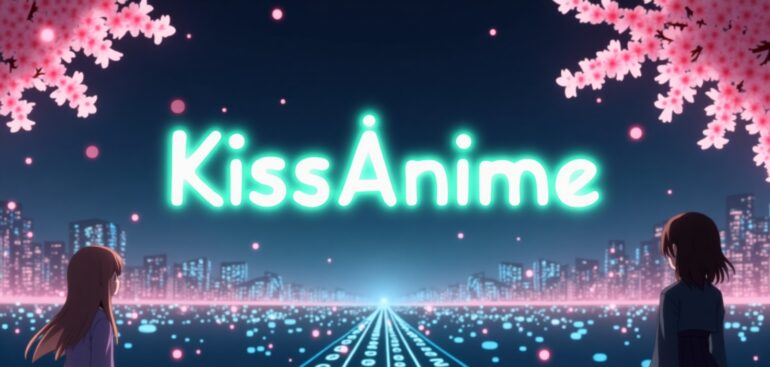In the annals of internet history, few websites command the same level of name recognition and complicated nostalgia within the anime community as KissAnime. For nearly a decade, it was the undisputed, if illicit, king of anime streaming, a veritable digital library that served as the entry point for millions of fans across the globe. Most people remember it for its two most prominent features: a seemingly infinite collection of anime and a “free” price tag that came with a minefield of pop-up ads.
But the full story of KissAnime is far more complex and fascinating than just that. Its operation, its relationship with its community, and its eventual downfall are filled with surprising details and lesser-known facts. This article goes beyond the surface to uncover five things you probably didn’t know about one of the most impactful and controversial websites in anime history.
1. It Was Part of a Larger “Kiss” Piracy Empire
While KissAnime was the flagship and most famous brand, it was not a standalone entity. It was the crown jewel of a much larger, interconnected network of piracy websites, all operating under the “Kiss” brand. This digital empire was a deliberate and strategic effort to dominate multiple sectors of online entertainment, using a recognizable name and a similar user interface to capture a massive audience.
The most well-known of these sister sites were:
- KissManga: The second most popular site in the network, it served the same function as KissAnime but for Japanese manga. It offered a colossal library of scanned and translated manga chapters, allowing users to read entire series for free.
- KissAsian: This site catered to fans of live-action content from across Asia. It hosted a huge collection of Korean dramas (K-dramas), Japanese dramas (J-dramas), and films from various other Asian countries.
- KissCartoon: Focused on Western animation, this site provided access to a vast catalogue of American and European cartoons, from classic Saturday morning shows to modern animated series.
This network strategy was incredibly effective. The sites would often cross-promote each other, directing traffic back and forth. A user who finished an anime on KissAnime might be guided to KissManga to read the source material. This created a powerful, self-sustaining ecosystem that locked users into the “Kiss” brand for all their entertainment needs. The similar layout and functionality across the sites made it easy for users to navigate any of them, reinforcing brand loyalty and making the empire a formidable force in the world of online piracy.
2. Its Comment Section Was a Deliberate Community-Building Engine
Many websites have comment sections, but KissAnime’s was different. It was a core, defining feature that was instrumental to its success and a primary reason for its “sticky” user retention. The platform used a Disqus integration placed directly below every single video player, and this transformed the solitary act of watching anime into a vibrant, shared, real-time event.
The power of this feature lay in its immediacy and specificity. Unlike a subreddit or a separate forum where discussions are generalized, the comments on KissAnime were tied to a single episode. Moments after finishing a thrilling cliffhanger or a heartbreaking scene, a viewer could scroll down and be met with thousands of other people experiencing that exact same emotion at the exact same time. The comment section served multiple functions:
- A Hub for Instant Reactions: It was a place for emotional catharsis—expressing shock, joy, sadness, or anger with a community that understood completely.
- A Forum for Theory-Crafting: Fans would immediately begin debating what would happen next, analyzing foreshadowing, and crafting intricate theories.
- A Source of In-Jokes and Memes: Each episode would generate its own unique set of memes and running gags, creating a rich sub-culture around every popular show.
This feature made users feel like they were part of a massive, exclusive club. They returned not just to watch the next episode, but to participate in the ongoing conversation surrounding it. This powerful sense of community is something many legal services, with their disconnected forums and Discord servers, have struggled to replicate, and it remains one of the most deeply missed aspects of the KissAnime experience.
3. It Waged a Constant Technical War Against Adblockers
The price of “free” on KissAnime was a notoriously aggressive and intrusive advertising experience. The site was infamous for its layers of pop-ups, pop-unders, and redirect ads, many of which were malicious. To combat this, most users naturally turned to ad-blocking browser extensions like Adblock Plus and uBlock Origin. This, however, kicked off a relentless, behind-the-scenes technical war between KissAnime’s developers and the ad-blocking community.
This wasn’t a simple block; it was a constant cat-and-mouse game. Here’s how it worked:
- KissAnime’s developers would write and implement a new script on the site. This script was designed to detect the presence of active ad-blocking software in a user’s browser.
- If an adblocker was detected, the script would prevent the video player from loading, often displaying a message demanding the user disable their adblocker to proceed.
- In response, the community of adblock users and filter list maintainers (on platforms like Reddit) would analyze the new detection script. They would work together to identify the specific code causing the block.
- They would then write and share new custom filters. Users could add these filters to their adblocker, which would then block not only the ads but also KissAnime’s new anti-adblock script itself.
- For a few days or weeks, everything would work perfectly again for users with the updated filters.
- Then, KissAnime’s developers would change their script again, breaking the filters and starting the cycle all over.
This ongoing battle was a fascinating, if frustrating, part of the KissAnime experience and a detail many casual users were unaware of. It showcased the dedication of both the site operators to secure their ad revenue and the community determined to have an ad-free experience.
4. Its Speed Was Powered by an Unsung Army of Fansubbers
One of KissAnime’s most celebrated features was the incredible speed at which new episodes of currently airing anime would appear on the site, often with English subtitles, just hours after their original broadcast in Japan. KissAnime itself, however, did not employ a team of translators.
The fansubbing scene was a cornerstone of the anime community for decades. These were volunteer groups of dedicated fans who would:
- Obtain a raw digital copy of the newly aired episode from Japan.
- Translate the Japanese dialogue into English.
- Time the subtitles to match the dialogue on screen.
- Typeset the subtitles with distinct fonts, colours, and on-screen notes to translate signs or text.
- Encode and release the final video file for free on torrent sites and file-hosting services.
KissAnime’s role in this ecosystem was that of an aggregator. Its systems would automatically scan these piracy channels for new fansub releases. The site also famously used rips from legal streaming services like Crunchyroll (a practice embodied by groups like “HorribleSubs”), which provided high-quality video and official subtitles almost instantly. Therefore, KissAnime’s legendary speed was not due to its own efforts, but rather its efficiency in collecting and centralizing the work of this entire unsung army of fansubbers and rippers.
5. Its Shutdown Was the Result of Landmark International Legislation
Many users believe KissAnime was shut down by a single, powerful company or that it simply vanished. The reality is that its demise was the first and most high-profile casualty of a landmark piece of international anti-piracy legislation enacted in Japan.
However, in 2020, Japan’s parliament passed a sweeping revision to its copyright law that created a much more aggressive and comprehensive anti-piracy framework. The new law gave Japanese publishers and production companies immense power to target piracy on a global scale. The key changes that sealed KissAnime’s fate were:
- The Criminalization of “Leech Sites”: The law made it a serious crime to operate sites whose primary function was to provide an organized list of links to pirated material. This described KissAnime’s entire business model perfectly.
- Expanded International Cooperation: The law facilitated greater cooperation between Japanese copyright holders and international law enforcement, allowing them to target servers and site operators located outside of Japan more effectively.
This new legal arsenal is what empowered copyright holders to finally launch a successful, fatal attack on KissAnime’s infrastructure. When the site announced its closure on August 14, 2020, citing the takedown of its video servers, it wasn’t a random event. It was the direct result of this new, aggressive legal posture.
Conclusion
Understanding these lesser-known details provides a more complete appreciation for the site’s immense impact and reveals why, for better and for worse, it holds such a unique and enduring place in the history of the anime fandom.




